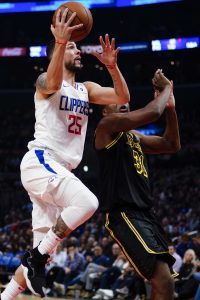We’ll soon find out what the NBA’s exact salary cap figure for 2018/19 will be, but for now the projection for next season remains at $101MM, a modest increase over 2017/18’s $99.093MM figure. The cap is unlikely to fall precisely at $101,000,000, but if it does, it will represent an increase of approximately 1.92% over the previous season, which is important.
Under the NBA’s new Collective Bargaining Agreement, several other figures are tied to how much the salary cap increases on a year-to-year basis. If the cap goes up by 1.92%, those other figures will increase by 1.92% too.
Once the NBA makes the salary cap for 2018/19 official, we’ll be able to fill in the blanks and determine what a number of other exceptions and salaries will be worth. Until then, here’s a breakdown of some of the other figures impacted by the cap increase:
Mid-level, bi-annual, and room exceptions:
The mid-level and bi-annual exceptions are available to teams over the cap and under the tax apron. The room exception is available for teams that use cap space, while the taxpayer mid-level exception is for taxpaying teams. All of these exceptions will increase by the same percentage that the cap does.
For instance, in 2017/18, the full mid-level exception for non-taxpaying clubs was worth $8,406,000. If the cap increases to $101MM for 2018/19, the MLE next season will be worth $8,567,770. In the unlikely event that the cap jumps by 5%, the mid-level would be worth $8,826,300.
The same applies to the rest of these exceptions. For example, the bi-annual exception in 2017/18 was worth $3,290,000. A $101MM cap would take it up to $3,353,315 for 2018/19.
Maximum salaries:
As was the case under the league’s old Collective Bargaining Agreement, maximum salaries hinge on the value of the salary cap, since they’re determined by calculating a percentage of the cap.
Maximum salaries can be worth 25%, 30%, or 35% of the cap, depending on a player’s years of experience and certain other criteria. So, in 2017/18, for a $99,093,000 cap, the three maximum salaries were $24,773,250 (25%), $29,727,900 (30%), and $34,682,550 (35%).
In 2018/19, those maximum-salary figures will increase along with the cap, which is why we don’t yet know what the first year of Andrew Wiggins‘ and Joel Embiid‘s new max extensions will be worth. Based on a $101MM cap projection, they’d have starting salaries of $25,250,000, but that number could change depending on where the cap lands.
Minimum salaries:
The NBA’s new CBA calls for minimum salaries to be dictated by the cap increase as well, which wasn’t the case under the old CBA.
Minimum salaries vary depending on how many years of NBA experience a player has, but in 2017/18, the rookie minimum was $815,615, while the minimum for a player with 10+ years of experience was worth all the way up to $2,328,652.
Assuming the 2018/19 cap falls exactly at $101,000,000, the rookie minimum would be $831,311, while the minimum for a players with 10+ years of experience would be $2,373,466.
The minimum salary for a player with two years of NBA experience is the one that shows up most frequently on teams’ cap sheets. That’s because a player with three-plus years of NBA experience who signs a one-year, minimum-salary contract only has a cap hit equivalent to the player with two years of experience — he earns a larger salary, but the league covers the difference.
In 2017/18, that cap charge for a player with two years of experience was $1,471,382. Based on a $101MM cap, it would be $1,499,698.
Cash available in trades:
The NBA limits the amount of money a team can send out and receive in a league year. In 2017/18, a team was limited to sending and receiving $5.1MM — those are two separate limits, so a club could send out $5.1MM in one trade, then take back $5.1MM in another.
That limit will be directly tied to the cap increase as well. Based on a $101MM cap, the limit would increase to $5,198,147 for 2018/19.
Rookie scale for first-round picks:
Each first-round pick is subject to the NBA’s rookie scale, which locks in a specific value for a player’s first NBA contract depending on where he was picked in the first round. For example, in 2017/18, No. 1 overall pick Markelle Fultz had a cap charge of $7,026,240 based on the rookie scale. On the other end of the spectrum, the first-year cap hit for No. 30 pick Josh Hart was just $1,394,520.
The NBA is currently phasing in a gradual increase in rookie salaries, so determining the 2018/19 scale isn’t as simple as factoring in the cap increase. As Larry Coon explains within the CBA FAQ, calculating next season’s rookie scale involves something called a “baseline scale.” The formula for determining the ’18/19 rookie scale is as follows:
- Apply the percentage of the cap change from 2017/18 to 2018/19 to the ’17/18 baseline scale to create an ’18/19 baseline scale.
- Increase the 2018/19 baseline scale by 30% to create the actual rookie scale.
- Increase the new rookie scale amounts by 20% to get the cap holds and likely salaries for 2018 first-rounders.
Based on a $101MM cap, the probable salary for this year’s No. 1 pick (Deandre Ayton) would jump to $8,095,595. This year’s 30th overall pick, Omari Spellman, would be in line for a $1,606,717 starting salary. Once again though, these figures could end up higher or lower, depending on where the cap for 2018/19 ultimately lands.
Larry Coon’s CBA FAQ was used in the creation of this post.
